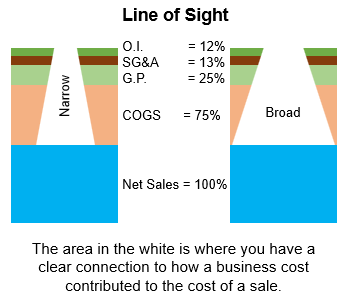
The people who collect a paycheck from you either have a Line of Sight to how their work contributes to planned business results, or they don’t.
Employees with poor to no Line of Sight to how what they do matters rarely contribute more to the business than they cost the business. Use the Contributions Management Process to help people connect how what they do or don’t do shapes changes in Net Sales, Gross Profit, and Operating Income.
Overview
Line of Sight is the area in view from an observer’s eye unobstructed to a distant point. In business Line of Sight means that employees can see the connection between what’s expected of them in realizing the goals for the business. E mployee’s best efforts are more likely to exist when they can see how their actions contribute to the results of the business. That the work they are paid to perform matters.
The most senior leader of a business, be it the owner, president, or CEO, is accountable for creating a Line of Sight to what is to be accomplished first in their mind so they can help those in the business create their Line of Sight to how their role contributes to planned business results. The goal is to help people see how they contribute to Net Sales, Gross Profit, and Operating Income. When people see how their business contributions impact sales and profits, they are more likely to be accountable for the results of their actions.
If people can’t see how what they do impacts sales and profits, then you either need to help them make the connection so you can benefit from their discretionary efforts, or you can be a dictator that dictates what each employee does when. Those who choose to dictate at best get compliance to getting done what was commanded, but they never get the benefit of an employee taking personal initiative. It’s easier for them to wait for the next set of orders than it is to risk taking initiative and being reprimanded for it.
Employees with poor to no line of sight to how what they do matters rarely contribute more to the business than they cost the business. Use the Contributions Management Process to help people connect how what they do or don’t do shapes changes in Net Sales, Gross Profit, and Operating Income.